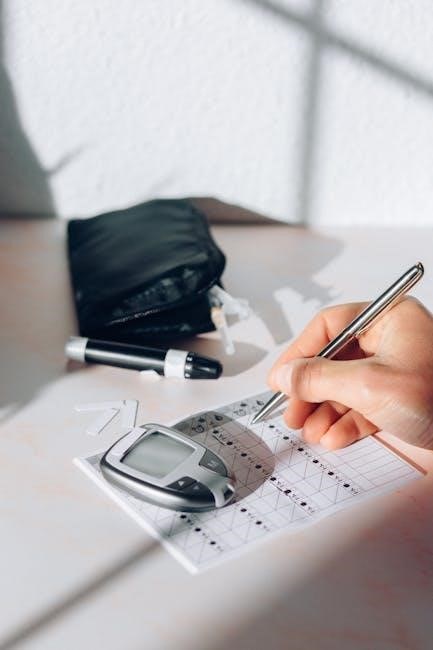A Do Not Disturb sign is essential for maintaining focus during tests or quiet activities․ This PDF guide offers customizable designs to ensure uninterrupted environments, perfect for schools, offices, or homes․

Overview of the Importance of Do Not Disturb Signs
Do Not Disturb signs play a crucial role in maintaining focus and minimizing interruptions during critical activities like exams, study sessions, or quiet time․ They ensure privacy and productivity, especially in environments where concentration is key․ These signs are versatile and can be used in educational settings, home offices, or shared spaces․ By clearly communicating the need for uninterrupted time, they help maintain order and respect for individuals’ work or study sessions․ Their importance extends to legal compliance and professional etiquette, ensuring that the message is conveyed effectively without ambiguity․ With customizable designs and easy-to-print PDF options, Do Not Disturb signs are a practical solution for creating a distraction-free environment․ They are essential tools for anyone seeking to preserve focus and efficiency in both personal and professional settings․
Why “Testing Do Not Disturb Sign PDF” is Relevant
The “Testing Do Not Disturb Sign PDF” is a valuable resource for anyone needing to communicate the need for uninterrupted time․ Its relevance lies in its versatility, as it can be used in various settings, such as schools, home offices, or public spaces․ The PDF format ensures easy downloading and printing, making it accessible to everyone․ This sign is particularly useful during exams, study sessions, or quiet hours, helping to minimize distractions and maintain focus․ Its customizable designs allow users to tailor the sign to their specific needs, ensuring clarity and effectiveness․ Additionally, the inclusion of visual elements, such as illustrations, enhances visibility and ensures the message is quickly understood․ By providing a professional and clear communication tool, the “Testing Do Not Disturb Sign PDF” supports productivity and respect for privacy in any environment․
How to Use the PDF Format for Do Not Disturb Signs
Using the PDF format for Do Not Disturb signs is straightforward and efficient․ First, select the desired design from the available options, ensuring it aligns with your needs․ Click on the image to download the PDF file to your computer․ Once downloaded, open the file using a PDF viewer and print it on standard paper or cardstock for durability․ Customize the sign if needed, such as adding specific text or adjusting the layout․ Mount or laminate the printed sign for long-term use․ Place it in a visible location, such as a door or wall, to ensure maximum visibility․ The PDF format ensures high-quality printing and maintains the design’s clarity․ This method is ideal for schools, home offices, or public spaces, providing a professional and clear way to communicate the need for privacy or focus․

Design and Customization of Do Not Disturb Signs
Customize templates with vibrant colors, bold fonts, and eye-catching visuals to ensure clarity and professionalism, making your sign stand out and convey the message effectively․
Popular Design Options for Do Not Disturb Signs
Popular design options for Do Not Disturb signs often include bold graphics, such as a hand or door symbol, paired with clear text․ Bright colors like red or yellow enhance visibility, while simple fonts like Arial ensure readability․ Many designs incorporate a professional yet approachable aesthetic, suitable for both residential and commercial use․ Some templates feature customizable fields for names or specific instructions, adding a personal touch․ Modern designs may also include QR codes or logos for branding purposes․ The combination of visual and textual elements ensures the sign’s message is conveyed effectively․ These designs are widely available in PDF formats, making them easy to download, edit, and print for immediate use․ The variety of styles caters to different preferences, ensuring the sign blends with its environment while maintaining its purpose․
How to Personalize Your Do Not Disturb Sign
To personalize your Do Not Disturb sign, start by selecting a PDF template that allows customization․ Use PDF editing tools like Adobe Acrobat or online editors to add your name, specific instructions, or contact information․ Choose a clear, readable font and bold colors like red or yellow to enhance visibility․ Incorporate personal touches such as a logo, icon, or image that aligns with your preferences or brand; Ensure the text is concise and the design remains professional while reflecting your style․ Save your edited version and print it on high-quality paper or cardstock for durability․ This personalized approach ensures the sign effectively communicates your needs while maintaining a tailored appearance․
Color Schemes and Visual Elements to Enhance Visibility
Selecting the right color schemes and visual elements is crucial for ensuring your Do Not Disturb sign is easily noticeable․ High-contrast color combinations, such as red on white or black on yellow, are ideal for maximizing visibility․ Bold patterns like stripes or checkerboard borders can also draw attention․ Incorporate universal symbols, such as a hand gesture or a crossed circle, to quickly convey the message without relying solely on text․ Avoid clutter by keeping the design clean and focused on the main message․ Ensure typography is large and clear, using sans-serif fonts for better readability․ Adding reflective or glossy finishes can enhance visibility in low-light environments․ By combining these elements, your sign will stand out and effectively communicate your request for privacy․

Functionality of Do Not Disturb Signs
Do Not Disturb signs clearly communicate the need for privacy, ensuring minimal interruptions․ They are effective in both personal and professional settings, promoting productivity and respect for personal space․
What a Do Not Disturb Sign Communicates
A Do Not Disturb sign clearly communicates the need for privacy and uninterrupted time․ It serves as a direct and non-verbal cue, ensuring others understand boundaries․ The sign is universally recognized, making it an effective tool for conveying unavailability․ In various settings, such as hotels, homes, or offices, it reduces unnecessary interruptions and distractions․ By displaying the sign, individuals signal that they are indisposed or focused on tasks requiring concentration․ This clear communication helps manage expectations and prevent misunderstandings․ The sign also fosters respect for personal space, promoting a balance between accessibility and privacy․ Its simplicity and clarity make it an essential tool for maintaining productivity and tranquility in both private and professional environments․
How to Ensure Compliance with the Sign’s Message
Ensuring compliance with a “Do Not Disturb” sign involves strategic placement and clear communication․ Position the sign in a highly visible location, such as a door at eye level, to maximize visibility․ Use large, bold fonts and bright colors to capture attention․ In busy environments, adding visual cues like symbols can enhance recognition․ Consider cultural differences in messaging; direct or polite phrasing may vary in effectiveness․ Implementing policies that outline consequences for ignoring the sign can reinforce respect․ Tailor the sign’s message to its purpose, such as “Do Not Disturb ⎯ Recording in Progress,” for greater seriousness․ Testing different designs and gathering feedback can identify the most effective version․ Finally, educating others about the importance of respecting the sign and its benefits can increase compliance, creating a more considerate environment for all․

Using the Sign in Different Environments
The versatility of a “Do Not Disturb” sign allows it to be effective in various settings․ In home offices, it helps maintain focus by signaling to family members or roommates when privacy is needed․ In hospitals, the sign is crucial for patient rest and recovery, ensuring minimal interruptions․ Hotels widely use these signs to respect guests’ privacy during their stay․ In shared workspaces, the sign helps colleagues understand when someone is unavailable for meetings or discussions․ For public or shared spaces like libraries or study halls, it promotes a quiet environment conducive to concentration․ By adapting the sign’s design and message to fit the specific environment, its effectiveness increases․ Testing the sign in different locations ensures it communicates clearly and is respected by others, making it a valuable tool for maintaining privacy and focus across diverse scenarios․
Downloading and Printing the PDF
Downloading and printing the PDF ensures your Do Not Disturb sign is clear and professional․ Follow simple steps using standard software and a printer for crisp, readable results․
Step-by-Step Guide to Downloading the PDF
To download the “Testing Do Not Disturb Sign PDF,” locate the download link on a trusted website or platform․ Ensure your device has a stable internet connection for a smooth process․ Click the “Download” button, and select a save location, such as your Downloads folder․ The PDF may automatically download or prompt you to choose a format․ Save it in a easily accessible location, like your desktop, for quick access later․ If prompted, enter any required details, such as an email address, to access the file․ Once downloaded, open the PDF using a compatible viewer like Adobe Acrobat or your device’s default PDF reader․ Verify the file is complete and printable before proceeding․ This step ensures you have a clear, professional Do Not Disturb sign ready for use․
Printing Tips for High-Quality Results
For high-quality printing of the “Testing Do Not Disturb Sign PDF,” use a reliable printer with high-resolution capabilities․ Choose sturdy, bright white paper to ensure vibrant colors and sharp text․ Select the “High Quality” or “Best” print setting in your printer software and specify the correct paper type to avoid ink bleeding or blurry text․ Ensure your printer is calibrated and has the latest drivers installed for optimal results․ For color accuracy, use the “CMYK” color profile if available․ Print a test page on regular paper to preview the output before using premium stock․ Avoid over-saturation by ensuring ink or toner levels are adequate․ Properly align the paper in the printer tray to prevent misprints․ Laminate the sign after printing for durability, if desired․ Regularly clean your printer to maintain performance and achieve professional-looking results․
Troubleshooting Common Printing Issues
When printing the “Testing Do Not Disturb Sign PDF,” common issues may arise, such as misalignment, pixelation, or color mismatches․ Ensure the PDF is downloaded correctly and not corrupted․ If text appears blurry, check the print resolution and DPI settings, aiming for at least 300 DPI․ For misalignment, adjust the printer’s margins or calibrate the printer․ If colors do not match expectations, verify the color profile settings or switch to a different paper type․ Connectivity issues between the printer and device can be resolved by restarting both or reinstalling printer drivers․ Paper jams should be addressed by carefully removing stuck paper and ensuring proper alignment․ For persistent problems, consult the printer’s manual or contact customer support․ Testing the print on plain paper first can help identify and fix issues before using premium stock․

Use Cases for Do Not Disturb Signs
Do Not Disturb signs are versatile tools for minimizing interruptions in homes, offices, schools, hospitals, and hotels, ensuring privacy during focused work, medical rest, or personal time․
Do Not Disturb Signs in Educational Settings
In educational environments, Do Not Disturb signs play a crucial role in maintaining focus and minimizing disruptions․ Classrooms, libraries, and study halls benefit from these signs to ensure students can concentrate during exams or quiet hours․ Teachers and staff also use them to signal when they are in meetings or working on critical tasks․ Additionally, these signs are useful in labs or specialized learning spaces where uninterrupted time is essential․ Schools can customize the signs to include specific instructions or branding, making them a versatile tool for fostering productivity and respect for privacy․ By clearly communicating boundaries, Do Not Disturb signs help create an environment conducive to learning and professional development․
Using the Sign in Home Offices and Workspaces
In home offices and workspaces, Do Not Disturb signs are essential for maintaining productivity and professionalism․ They help remote workers or freelancers signal to family members or roommates when they are unavailable for interruptions․ The PDF format makes it easy to download and print these signs, ensuring they are visible and clear․ Customization options allow users to add personal messages or company branding, enhancing their effectiveness․ Placing the sign on a door, desk, or even a monitor can deter disturbances during critical tasks or video calls․ By setting clear boundaries, these signs foster a balanced work environment and protect valuable worktime․ They are a simple yet effective tool for enhancing focus and efficiency in any workspace․
Applying the Sign in Public or Shared Spaces
Do Not Disturb signs are invaluable in public or shared spaces, such as libraries, hospitals, or conference rooms, where privacy and focus are essential․ These signs help communicate boundaries clearly, ensuring uninterrupted time for tasks or meetings․ The PDF format allows easy customization and printing, making it simple to adapt the sign for various environments․ In shared workspaces, they can prevent distractions and promote productivity․ Placing the sign in visible areas, like doors or walls, ensures maximum visibility and adherence to the message․ Testing different designs or messages in these settings can help determine the most effective version․ By using these signs, individuals and organizations can foster respect for personal space and maintain a professional atmosphere in public areas․ This tool is a practical solution for balancing accessibility and concentration in shared environments․

Legal and Professional Considerations
Ensure the sign complies with local laws and workplace policies to avoid legal issues․ Professional etiquette demands clear communication to maintain respect and order in shared environments․
Ensuring the Sign is Legally Compliant
To ensure the “Do Not Disturb” sign is legally compliant, it must adhere to local laws and workplace policies․ Check regulations regarding signage content, size, and placement․ In public spaces, ensure compliance with accessibility standards, such as ADA requirements․ Verify that the sign’s wording and design do not infringe on intellectual property rights․ In workplaces, consult with HR or legal teams to align the sign with company policies․ For residential use, confirm that the sign meets community or landlord guidelines․ Regularly update the sign to reflect changing laws or regulations․ Legal compliance ensures the sign is enforceable and respected, avoiding potential disputes or violations․ Always consult legal experts if unsure about specific requirements․
Professional Etiquette with Do Not Disturb Signs
Professional etiquette with “Do Not Disturb” signs involves respecting boundaries while maintaining a courteous environment․ Ensure the sign is clear and polite, avoiding aggressive language that may offend․ Place the sign in visible locations like doors or desks, but not in ways that obstruct pathways or violate workplace rules․ Communicate the purpose of the sign to colleagues or visitors beforehand to avoid misunderstandings․ When the sign is displayed, minimize interruptions, but remain approachable for urgent matters․ Consistency in using the sign helps others understand its purpose․ In shared spaces, consider cultural or organizational norms to avoid unintended offense․ By balancing privacy and accessibility, the sign fosters respect and productivity․ Proper etiquette ensures the sign is seen as a tool for efficiency, not isolation․
Liability and Responsibility When Using the Sign
Using a “Do Not Disturb” sign carries both liability and responsibility, particularly in professional or public settings․ The individual displaying the sign must ensure it is clear, unambiguous, and placed appropriately to avoid misunderstandings․ Failure to communicate the sign’s purpose effectively may lead to liability issues, especially in environments like workplaces or healthcare facilities․ Responsibility lies with the user to update the sign as needed and ensure it does not violate local laws or organizational policies․ In cases where the sign is ignored, the user may not be legally protected if the sign’s wording or placement is deemed inadequate․ It is crucial to balance privacy needs with the duty to maintain safety and accessibility․ Proper use of the sign demonstrates respect for others while minimizing potential legal or professional repercussions․

Best Practices for Displaying the Sign
Display the sign prominently at eye level, ensuring visibility and clarity․ Use bright colors and secure placement to prevent tampering․ Ensure the message is clear and compliant with local regulations․
Optimal Placement for Maximum Visibility
To ensure your “Do Not Disturb” sign is effective, place it in high-traffic areas where it can easily catch attention․ Position the sign at eye level, typically between 4-6 feet from the ground, to maximize visibility․ Avoid obstructing the sign with furniture or decorations․ For doors, center the sign to make it immediately noticeable․ In shared spaces, consider placing multiple signs at key entry points or intersections․ Use lighting to enhance visibility, especially in low-light environments․ Test the sign’s placement by observing how easily it is seen from different angles and distances․ Secure the sign firmly to prevent it from falling or being moved․ In digital formats, ensure the sign is displayed prominently on screens or devices․ Regularly inspect the sign’s condition and adjust its placement as needed to maintain effectiveness․
When to Use the Sign Effectively

The “Do Not Disturb” sign is most effective when used during focused work hours, meetings, or personal time requiring uninterrupted concentration․ In home offices, display the sign during video calls or deadlines to signal unavailability․ In healthcare settings, use the sign to protect patient privacy or during sensitive procedures․ For shared living spaces, employ the sign to maintain personal boundaries during rest or private activities․ Consistency is key; using the sign regularly helps others recognize and respect its purpose․ Test the sign’s effectiveness by observing how well it communicates your needs without causing confusion․ Adjust its use based on feedback and the specific context․ Ensure the sign is only used when necessary to avoid overuse, which may lead to disregard․ By strategically timing its use, you maximize its impact and maintain a balance between accessibility and privacy․
How to Store the Sign When Not in Use
Proper storage of your “Do Not Disturb” sign ensures its longevity and maintains its professional appearance․ When not in use, keep the sign in a dry, clean environment away from direct sunlight to prevent fading․ Store it in a protective sleeve or folder to avoid creases and damage․ For multiple signs, organize them in a binder or file with clear labels for easy access․ If the sign is printed on paper, consider laminating it for added durability․ Avoid folding the sign; instead, roll it and place it in a sturdy tube or cylindrical container․ Ensure the storage area is cool and moisture-free to prevent warping or moisture damage․ Label the storage container clearly so others can easily locate it․ By following these steps, your “Do Not Disturb” sign will remain in excellent condition for future use․ Regularly inspect stored signs for any signs of wear and replace them if necessary;
Testing and utilizing a “Do Not Disturb” sign PDF ensures privacy and professionalism in various settings․ Regularly evaluate and update your sign to maintain effectiveness and adapt to changing needs․

Final Thoughts on the Importance of Testing
Testing the “Do Not Disturb” sign PDF is crucial to ensure its effectiveness and clarity․ By evaluating the sign in real-world scenarios, you can identify design or textual flaws that may hinder its purpose․ Feedback from others helps refine the message, guaranteeing it is universally understood․ This step prevents misunderstandings and ensures compliance with professional standards․ Thorough testing leads to a polished product that clearly communicates the need for privacy, enhancing both functionality and professionalism in various settings․
Future Trends in Do Not Disturb Signage
The future of “Do Not Disturb” signage is likely to embrace digital innovation and sustainability․ Digital signs, powered by apps, will allow real-time customization and scheduling․ Hotels and offices may adopt smart signs that automatically update based on predefined times or events․ Additionally, eco-friendly materials will become more prevalent, reducing environmental impact․ Universal design principles will ensure signs are accessible to all, including those with disabilities․ As technology advances, signs may integrate QR codes or NFC tags for additional information․ Customization options will expand, enabling users to tailor messages and designs to specific needs․ These trends will enhance functionality, professionalism, and adaptability, making “Do Not Disturb” signs more effective in diverse settings․ Embracing these innovations ensures the signs remain relevant and practical in an evolving world․ Stay ahead with modern solutions that prioritize clarity, convenience, and sustainability․
Encouragement to Implement the Sign
Implementing a “Do Not Disturb” sign is a simple yet effective way to maintain focus and privacy in various settings․ By using this sign, individuals can clearly communicate their need for uninterrupted time, fostering respect and understanding from others; With the convenience of a downloadable PDF, creating and displaying the sign is hassle-free․ It not only enhances productivity in professional environments but also promotes a peaceful atmosphere in personal spaces․ Encourage others to adopt this practice to ensure mutual respect and efficiency․ Embrace this practical solution to protect your time and mental well-being, making it easier for everyone to prioritize tasks and maintain harmony in shared spaces․ The ease of customization and accessibility of the PDF format makes it an ideal choice for anyone seeking to implement this beneficial tool․



